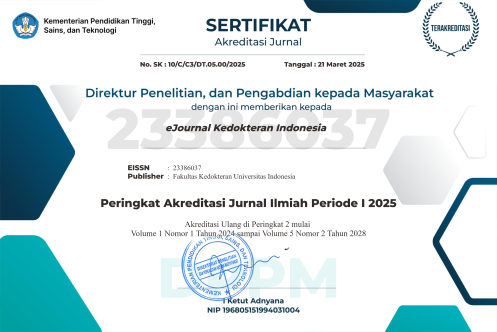Clinicopathologic and Histomorphological Aspect of Basal Cell Carcinoma in Dr. Cipto Mangunkusumo Hospital: A Retrospective Analysis of Twenty Years Experience
DOI:
https://doi.org/10.23886/ejki.9.34.118Keywords:
basal cell carcinoma, retrospective, epidemiology, histopathological profileAbstract
Basal cell carcinoma (BCC) is the most common skin malignancy, and the incidence increases over time. However, epidemiological data and analysis of the histopathological characteristic of BCC in Asia and Indonesia are limited. This study evaluates the clinicopathological and histomorphological features of BCC cases at Dr. Cipto Mangunkusumo Hospital (CMH) for the last 20 years (2000-2019). This is a cross-sectional retrospective study, using medical records and slides data screened based on inclusion and exclusion criteria. The re-diagnostic assessment was performed independently by two investigators. Data were analyzed statistically by the chi-square test, Kruskal Wallis, and Mann Whitney tests. There were 896 cases of total 20 years, with an increase of 51.4% between the first and second decades, female: male ratio was 1.34: 1, the median age was 63 y.o (0-99), and 54% patient was 60-79 y.o. The majority of cases are located on the head, face, and neck (95.8%), nodular as the most common histological subtypes (49.2%), with adenoid as the highest number of variants (63.1%). Single vs mixed subtype BCC (58.4% vs 41.6%), low-risk vs high-risk BCC (53.9% vs 46.1%). There were different levels of risk and a number of subtypes based on anatomical location. The differences were also found in the number of subtypes, the aggressiveness of subtypes, and risk levels based on gender and histological subtypes based on anatomical location. Residual tumours were present in 2.8% of cases. Thus the cases of BCC in CMH have increased in the last 20 years, and differences are observed in anatomical distribution, gender, age, risk, number of subtypes, histological subtypes, and aggressiveness.
Keywords: basal cell carcinoma, retrospective, epidemiology, histomorphological characteristics.
Aspek Klinikopatologis dan Histomorfologikal Karsinoma Sel Basal di Rumah Sakit Dr. Cipto Mangunkusumo: Analisis Retrospektif 20 Tahun
Abstrak
Karsinoma sel basal (KSB) merupakan keganasan kulit yang paling sering. Namun data epidemiologi dan telaah karakteristik histopatologi KSB di Asia dan Indonesia sangat terbatas. Penelitian ini bertujuan mengevaluasi kasus KSB di Rumah Sakit Dr. Cipto Mangunkusumo (RSCM) dan meninjau gambaran klinikopatologis serta histomorfologinya selama 20 tahun terakhir (2000-2019). Penelitian ini menggunakan desain potong lintang retrospektif dengan mengambil data dari rekam medis dan slide tersimpan. Skrining formulir permintaan patologi berdasarkan kriteria inklusi dan eksklusi. Penilaian diagnosis ulang dilakukan secara independen oleh dua peneliti. Data dianalisis dengan uji chi square, Kruskal Wallis, dan Mann Whitney. Terdapat 896 kasus KSB dalam waktu 20 thn dengan peningkatan 51,4% KSB antara dekade ke-1 dan ke-2, rasio perempuan: laki-laki adalah 1,34:1, median usia 63 tahun (0-99) dan 54% berusia 60-79 tahun. Lokasi anatomis terbanyak di kepala, wajah, dan leher (95,8%), subtipe nodular (49,2%) dengan varian adenoid tertinggi (63,1%). KSB subtipe tunggal vs. campuran (58,4% vs. 41,6%), KSB risiko rendah vs. tinggi (53,9% vs. 46,1%), terdapat beda tingkat risiko dan jumlah subtipe berdasarkan lokasi anatomis, jumlah subtipe, sifat agresivitas subtipe, dan tingkat risiko berdasarkan jenis kelamin, serta beda jenis subtipe dengan lokasi anatomis. Tumor residif terdapat pada 2,8% kasus. Kasus KSB di RSCM meningkat dalam 20 tahun terakhir dan perbedaan diamati pada distribusi anatomi, jenis kelamin, usia, risiko histopatologik, jumlah subtipe, berbagai subtipe histopatologi, dan agresivitasnya.
Kata kunci: karsinoma sel basal, retropsektif, epidemiologi, karakter histomorfologi.
Downloads
Downloads
Published
How to Cite
Issue
Section
License
Copyright (c) 2021 Riesye Arisanty, Muhammad Habiburrahman, Maria Angela Putri

This work is licensed under a Creative Commons Attribution-NonCommercial 4.0 International License.



